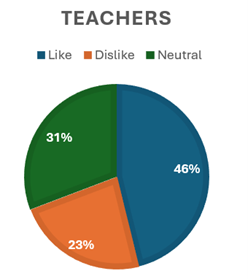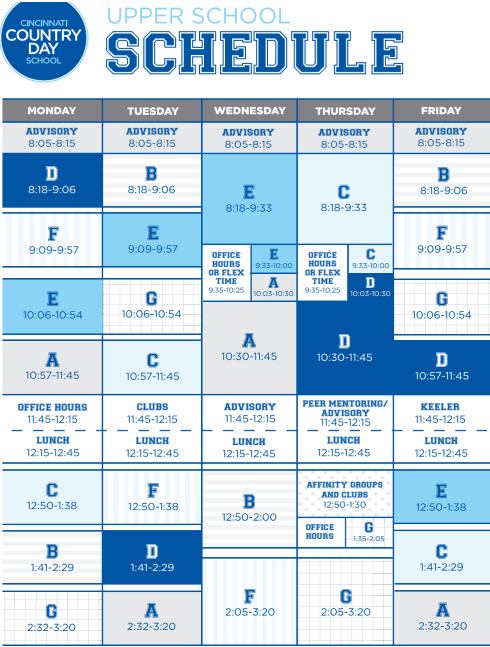The 2024-2025 school year has begun with many changes to the CCD community including new teachers, a new US carpet, and a new class schedule for the Upper and Middle School alike. Consisting of both days with block periods and all classes meet days, students and faculty have mixed feelings on this new schedule. It is often the subject of discussion or debate during class time with people choosing to defend it and others choosing to gripe about it. In this article, I aim to uncover people’s true feelings about the current schedule by sharing the opinions of as many students and teachers as possible. How do people really feel about the new schedule?
Out of the thirty-five students that I interviewed about their views on the schedule, twenty-four of them say they actively dislike our current schedule, two of them actively like it, and nine students say they are neutral, and do not like or dislike the schedule as a whole. As for the teachers, three say they dislike it, four of them are neutral, and six of them say they like it, at least comparatively to the one we used last year. If we look at these numbers using pie charts, it shows a significant difference between the preference of the teachers and the students. As I spoke to members of the community about their thoughts, the reasons for this difference became clear.


While many teachers mentioned that they like being able to meet with their classes nearly every day, almost every student said that having their classes more often gives them an extra amount of homework that they are sometimes unable to manage. Many student athletes commented on the fact that they have very little time to do homework at night due to long practices and games. Although most people enjoy having a five-day rotating schedule, having all classes meet three days a week means students have much more homework due each day than they did last year. From the teachers’ perspective, though, being able to get through more material is a good thing and a benefit of the new schedule.
Despite faculty and students disagreeing on the benefits of meeting with each class four times a week, there are also things that they seem to agree on in regard to the schedule. The majority of people seem to agree that they like having the Wednesday and Thursday block schedules, but they do not like the mass amounts of free time that they may have on these days. Some students and teachers have one or two classes on Thursday and are finished with everything before lunch. Many people, students and teachers alike, have said that they feel they do not have enough time to get everything done, sometimes due to the uneven distribution of free time. Since the schedule cuts down one bell from last year, people tend to have less free bells to get their work done. One teacher said, “I’ve never drunk more energy drinks in my life,” when telling me how exhausted the constant work and running around makes them feel.
On the other hand, one thing that has been well received by all involved is the addition of office hours into the regular Upper School schedule. Students like having a designated time to see their teachers and teachers like knowing that office hours make their students more willing to see them for help. Most people also enjoy the regularity of the new schedule compared to last year’s. It’s easier to make appointments during the day and easier to simply know what to expect for the week ahead. “Personally, I’m getting along great with the new schedule, although it is a very different feel from last year,” one student said, proving that not every difference is a negative one, despite the fact that it will take a while to get used to.
Many students with more negative opinions of the schedule shared with me their ideas for improving it in the future. Some of the suggestions were:
- Not having Keeler just once a week.
A couple of students have found that having Keeler once on Fridays is unhelpful, leaves announcements to pile up, and relays some information too late. This is compared to last year’s Keeler meetings on Tuesday and Thursday every week.
- Moving one of the all classes meet days to Wednesday.
Some people think that spreading out the all classes meet days would result in having less quizzes and tests piling up on Friday. While Tuesday may be too early in the week for teachers to give assessments, moving this day to Wednesday may entice some teachers to place their quizzes on that day instead of every teacher giving a quiz on Friday.
- Having longer passing periods.
Going from 5 minutes between classes to 3 minutes between classes is a bigger change for students than one might initially expect. Getting from one end of the school to the other can be a challenge by itself, and it is much more so when you factor in time to go to the bathroom or fill up your water bottle.
- Change the exact bell schedule of either Tuesday or Friday.
Although most of the days do a good job of changing up what time of day each class is, the Tuesday and Friday schedule have some important similarities that matter a lot to students who may not learn well at certain times. The first bell (B) and last bell of the day (A) happen to fall at the same time on both days.
As a whole, the feedback I have received has been that the shift from the old schedule to the new one has been difficult, as any major change is. There are things that teachers like, things that students like, and things that both groups dislike. Most people believe that as the schedule continues to be tweaked and as people adapt to it, comfort with everything will only grow. The homework load needs to be ironed out, students need to adjust to all classes meet, and everyone needs to get used to rushing from class to class, but office hours are a plus and scheduling appointments is easier. So, what’s the final verdict? Most students aren’t fans of the new schedule yet, but how is it, truly, long-term? The only thing that can be known for sure is what one faculty member said perfectly: “We’ll see once we’ve lived with it a bit longer.”






